Qijiang Tourism | Enjoying in Qi, Endless Qi Flavor [Text, Video]

Qijiang District, Chongqing
Chongqing Qijiang
One of the main urban new areas in Chongqing and the second batch of national comprehensive pilot areas for new urbanization
Take the high-speed train from Chongqing West to Qijiang East, and the train runs through green mountains and clear waters.
In less than half an hour, you can see the winding and flowing "Qijiang River"
Qijiang City, named after water, is known for its beautiful and graceful appearance
Marshal He Long, who once ruled the Southwest
I have praised it many times“ Qijiang is a good place ”
Have you ever been to Qijiang If not, then you must go take a look!
In this year's government work report, the concept of "expanding the main urban area" is clearly defined.
Among the 12 districts Qijiang Upgraded to, truly qualified Main urban area .

Qijiang Tourism Recommendation: The Perfect Combination of Cultural History and Natural Environment
Qijiang is a city with a long history and rich culture, dating back 1400 years. The earliest Communist Party branch in Chongqing was born here, which was the only place where the Central Red Army passed through Chongqing during the Long March. It is the hometown of Chinese farmers' printmaking. Here, there are beautiful and majestic ancient sword mountains, majestic old Ying mountains, beautiful Qi River water, and the nearby Hengshan peak. It is also home to the famous Chinese historical and cultural town of Dongxi Ancient Town, the Dinosaur Footprint Fossil National Geological Park, the most beautiful rural area in China, Yongcheng Zhonghua Village, and the city level tourist resort Hengshan. It is a popular destination for tourists from all over the world“ Health preservation, elderly care, and mental health ”Where“ Want to come, want to stay, miss ”The place.

Qijiang is the civilized urban area of Chongqing in 2019. It is a city surrounded by mountains and rivers, a great place to cool off and escape the heat, and a cultural place that inherits the "red" gene. Therefore, this itinerary is arranged around these two points:
Day 01 Hengshan Huaxian Valley, Gujian Mountain
Day 02: Wang Liang's former residence, Yongcheng blowing and beating, and retracement of the Long March Road (Red Army Bridge, Red Army Cave, Red Army Village, Shihao Red Army Martyrs Cemetery)
Day 03: Qijiang Museum, Qijiang Farmers' Printmaking Academy
Food check-in: Crispy Bay Fish, Stable Lamb, Beidu Fish
Accommodation recommendations: Starry Sky Camping (Suburban), Howard Johnson Hotel (Urban)

Take Provincial Highway 283 on Huaxian Valley Road in Hengshan, famous for its "3 bends and 9 turns"
The main filming locations for Andy Lau's' Lost Lonely '
Walk up the winding mountain road and you will reach the mountaintop. In summer, coming to Hengshan is a great place to enjoy tranquility, coolness, and relaxation. It is a great place to escape the summer heat.
Looking down from the mountaintop, winding roads float through the mountains like colorful ribbons, and large patches of green also come into view. From a distance, layers of clouds cover a corner of the sky, perfectly obscuring the glaring sunlight and adding a touch of coolness to this summer.

Coming to Qijiang gives me a feeling of good mood. When I reach the mountaintop, I feel like I'm in a fairyland, without any unnecessary noise or excitement, only the peaceful comfort of time. Qijiang is truly a desirable place.
Our first stop is "Hengshan Flower Immortal Valley"
Hengshan Huaxian Valley is located in Hengshan, Qijiang, with an average annual temperature of around 25 ℃. It is only a 70 minute drive from the main city and is known as the closest "air-conditioned health town" in Chongqing!
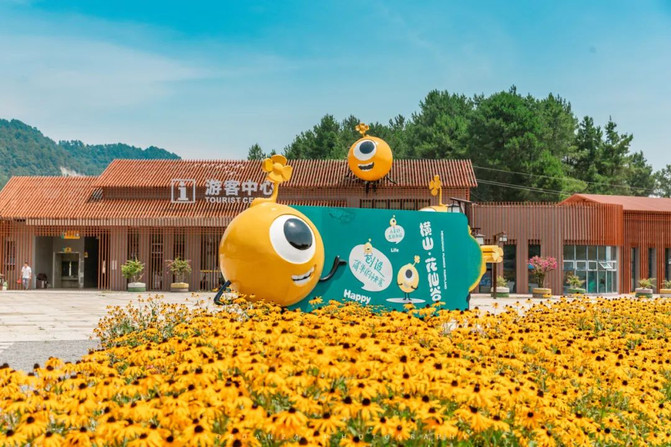
The Little Elf of Flower Valley: Flower Cubs

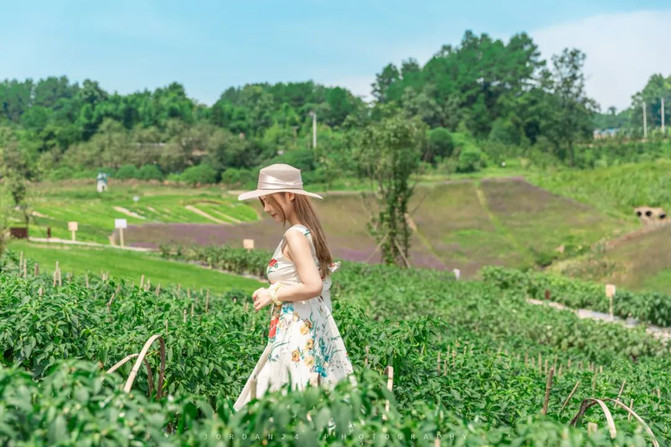
Covering 6 major themed functional areas, 5 major internet celebrity sea landscapes, over 10 internet celebrity check-in points, romantic flower sea, cute pet amusement park and more than 20 interactive experience projects, this is Chongqing's first composite leisure vacation destination that integrates sightseeing, outings, parent-child experiences, leisure vacations, and study tours

Watching the sea of flowers, taking beautiful photos, taking a walk with children, touching the clouds, sleeping when tired, waking up with scenery, and eating delicious food when hungry
This has a refined lifestyle, with a balance of movement and relaxation.

Blue purple flower spikes, fragrant and elegant, a purple ocean, the flower language of the horsewhip grass is: Looking forward to, Expectations are beautiful and worth longing for, just like how they are connected like stars.

In addition to these, there are also argali, pony, alpaca, peacock, black swan, and other cute and silly animals that children love very much. Here, it is very suitable for children to have intimate contact with animals, learn to love animals and protect nature, and combine education with entertainment.

As I joyfully searched for the scent of flowers like a child, I seemed to merge into the team of dragonflies and butterflies flying around me. After turning a bend, a magnificent sea of flowers undulating with the mountains came into view.

There is a Starry Sky Camping Base near the Flower Valley, which is a highlight scenic spot in Hengshan. The forest covers a large area and the negative oxygen ions are high. While running with the fragrance of flowers, we can feel all the natural things.
On summer nights, you can also camp and barbecue under the stars, listen to the chirping of cicadas and birds, and have children and cute pets play and frolic by the tent. Happiness becomes so simple.


Camping, stargazing, and every weekend, inviting three to five friends to find a scenic spot, setting up a tent on grass or bare soil, smelling the fragrance of soil and green grass, watching the sunrise together, singing old songs, telling stories... Experience the long-awaited return and comfort.

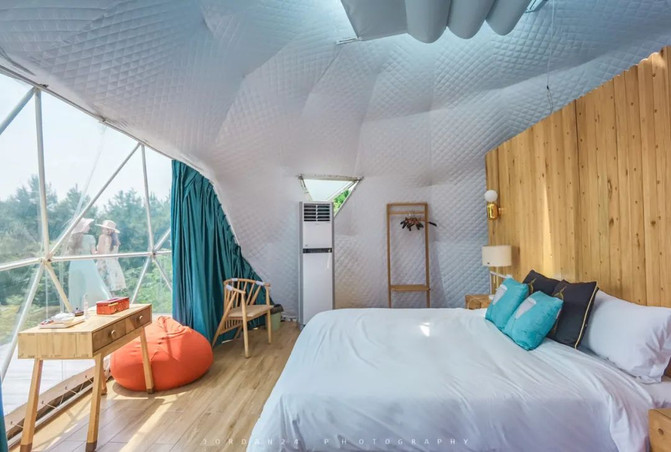

The second stop is "Gujian Mountain Scenic Area"
Gujian Mountain, also known as "Jigongzui", boasts stunning natural scenery and rich cultural landscapes, with an altitude ranging from 800 to 1300 meters. It is known as the Little Emei in eastern Sichuan and is also one of the twelve scenic spots in Ba and Yu.
Between the two isolated peaks on the cliff of Jigongzui, ancient people connected them by a stone arch bridge, Gu Mingyang Bridge. According to legend, a high monk from ancient Jian Mountain sacrificed his body here to climb to the Pure Land, also known as the Sacrificial Cliff.


The Jingyin Temple on the mountaintop is bustling with incense, with a constant stream of devout men and women. There is a saying that goes, 'The Bodhisattva with the mouth of a rooster should be far away, not near.'. The air in the mountains is humid, with high negative oxygen ions, and the ecological environment can be said to be very good. It is completely possible to get oxygen.

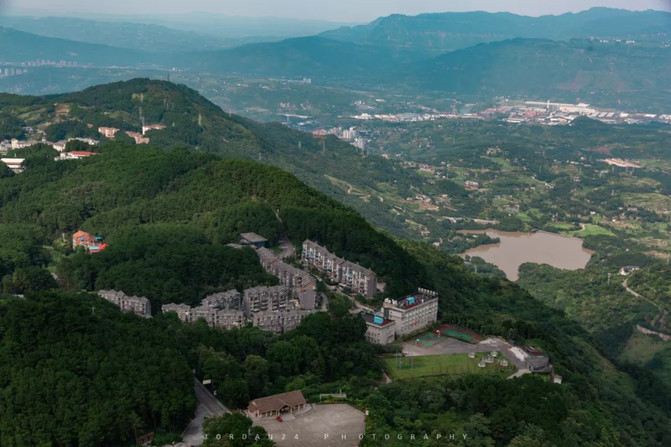
The Gujian Mountain Scenic Area covers an area of approximately 100 square kilometers, with the highest peak, Jigongzui, reaching an altitude of 1300 meters. It is China Forest Health City and National Geological Heritage Park. There are rare Danxia landforms and high mountain canyons in the scenic area; Multiple nationally protected animals and ancient trees; There are many natural and cultural landscapes such as the millennium old temple Jingyin Temple, the painter's village, and the drum beating stone.

Walking straight past Jingyin Temple, you will find a very interesting courtyard. Finally, you come to an observation deck where you can see Qijiang City, the road you came from, and the parking lot at the foot of the mountain. People who are afraid of heights may have weak legs, but standing here and looking around, they can truly feel the wonder of nature and the insignificance of humanity.

If an elderly person wants to offer incense but finds it difficult to climb the mountain, then it's okay. There is a road that leads directly to the top of the mountain and only requires a short walk to reach the temple.

Daqiaokou Reservoir
At the foot of Gujian Mountain, there are dozens of reservoirs of various sizes with good water quality, and fishing is generally allowed. There are many types of fish, including those with curved mouths. The fishing fee is also 30 yuan per day, and it is not allowed to fish for white carp. There are also many people who go there to escape the heat and cool off in summer.

Gujian Mountain Tent Camping Site
The campsite is a typical mountainous camping site, covering an area of 115 acres. It adopts a stepped and clustered construction, with 1 RV, 6 characteristic tents, 22 fixed tent campsites, 40 free tent campsites, 10 wooden cabin campsites, as well as a tourist reception center and bathroom, children's play area, barbecue area, etc. The functional areas are connected by a zigzag road.


Equipped with complete campsite facilities, such as independent drinking water and sewage treatment systems, as well as a comprehensive living electricity system, lighting system, WiFi system, modern shower, bathroom and other sanitary equipment, supermarkets, restaurants, laundry rooms, etc., it can meet the daily needs of tourists. The key is that the fees are reasonable, the standards vary, and the general working class can afford them.

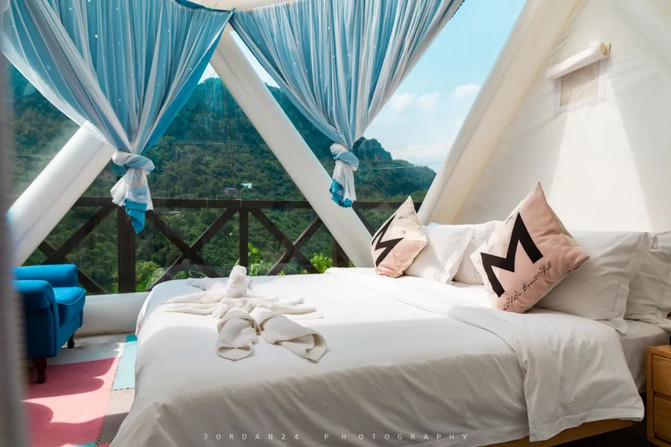



The third stop is "Wang Liang's Former Residence"
Qijiang is a city with a long history and rich culture, and it is also the only place where the Red Army passed through Chongqing during the Long March. General Wang Liang was born here.
Wang Liangyuan was the commander of the Red Fourth Army of the First Red Army, but his military career was only a short five years. However, he made great achievements in multiple anti encirclement and suppression operations. As a person born into a wealthy family, Comrade Wang Liang received a good education from a young age and learned both Chinese and Western cultures. Later, he followed his ideals and joined the army to participate in the revolution, which can be described as having both civil and military skills. In 1932, he was ordered to return to the Gannan base area and unfortunately sacrificed himself heroically.


The former residence of Wang Liang is arranged in a quadrangle courtyard, with one floor and one floor facing east and west, backed by Fengguan Mountain and facing Laoying Mountain. It is a typical Chuandong style building

Wang Liang is from Yongcheng Town, Qijiang District, Chongqing. He was a brave warrior who died before realizing his ambitions. He knows three foreign languages, joined the military at the age of 21, and studied at Huangpu Military Academy. His life was brilliant but brief, and he participated in many dangerous and intense wars against the enemy, achieving eternal military achievements.

Comrade Mao Zedong left behind a magnificent poem with his brush: 'Thousands of trees, frosty sky, red and vibrant; the anger of the heavenly soldiers rushes to the sky.'. In this war, it was General Wang Liang, a famous general and commander of the Fourth Red Army during the early days of the founding of the Chinese Workers' and Peasants' Red Army, who made outstanding contributions.



The entire exhibition room revolves around the life story of General Wang Liang, using various forms such as text, pictures, and physical objects to bring our thoughts back to the past era. The theme is distinct and can be divided into three exhibition halls: the main body of the former residence, the Red Qijiang, and the deeds of Wang Liang.


The fourth stop "Yongcheng Blows and Beats"
Yongcheng wind and percussion is a mountainous rural area in Chongqing, and folk wind and percussion music is the most popular, active, and historically oldest form of traditional music.
Yongcheng Blowing and Beating has a history of over 300 years. The Liu Family Music Troupe, which has the largest scale and influence, has been passed down for eighteen generations. Liu Jialeban was founded by Liu Yiwen from Xiniuping, Xiaogan, Hubei during the Ming Dynasty, with only six people at that time.





Fifth stop: retrace the Long March route
Red Army Bridge
Located in Shihao Town, Qijiang District, it was built in the Qing Dynasty. In January 1935, the First Red Army passed through this bridge. As it witnessed the history of the Central Red Army's Long March to Qijiang, later generations named it "Red Army Bridge"

He is a stone and wood structure bridge with a gable style blue tile roof design and a perforated beam frame, showcasing the authentic ancient bridge design. It is the Red Army Bridge, which carries more historical missions than traditional bridges and witnesses the turbulent years of the Red Army's Long March to Qijiang. It is like a mirror reflecting the past and present.
Strolling along the ancient bridge, one can almost hear the sound of Red Army soldiers shouting. In an instant, nearly a hundred years have passed like a white horse, but only the old bridge remains unchanged in color.


Red Army Cave
On January 21, 1935, the health team of the First Division of the Red First Army camped at the home of farmer Li Shuqing in Qishuping, Lihanba, Shihao. The next day, when the health team withdrew, four seriously injured soldiers from the Jiangxi Red Army were left behind, and Li Shuqing was entrusted to help with their care and recovery.
Li Shuqing transferred the wounded to the Yougangzui cave at the foot of the mountain behind the house to hide from the search of warlord troops. Li Shuqing's family took turns delivering meals and finding herbs to treat their wounds. In February and March of the same year, two Red Army soldiers sacrificed themselves due to severe injuries. Li Shuqing and farmer Tang Mingxing buried their bodies outside the cave;
One person left in April after recovering from injury; After recovering from his injuries, he helped with work at Li Shuqing's house. Two years later, he was captured by the Nationalist army in Tongdao Town and has been missing ever since. In memory of the sacrificed Red Army soldiers, the local people renamed the "Yougangzui Cave" to "Red Army Cave".

After parking, we need to walk about 500 meters on a mountain path to reach it Red Army Cave



Red Army Street
In Chonghe Village, An'an Town, Qijiang District, a journey full of red cultural memories is attracting more and more attention. Tourists walk on the trail, occasionally taking out their phones to check in and take photos, sharing their inner joy.

Chonghe Village is about an hour and a half drive from the urban area of Qijiang, bordering Yaolongshan Town in Tongzi County, Guizhou. It is a typical rural area with a border culture between Chongqing and Guizhou.




Coming here, the melody of 'Ten Farewell to the Red Army' always lingers in my ears. The Battle of Xiangjiang resulted in the highest number of casualties during the Long March of the Red Army, with the number of Central Red Army soldiers sharply reduced from over 86000 at the time of the Long March to just over 30000.
Shihao Red Army Martyrs Cemetery
After the founding of the People's Republic of China, the people of Qijiang turned over and liberated themselves, remembering their roots when drinking water. From 1964 to 1983, they successively built Red Army martyrs' tombs near Baiguo Village and Shihaochang, gradually relocating the loyal bones of the five Red Army martyrs together.

In 1991, it underwent renovation and expansion, and became the current Shihao Red Army Martyrs' Cemetery. The entire martyr's tomb consists of seven major parts: the Long March Poetry Stele, the Martyrs' Cemetery, the Martyrs' Statue, the Martyrs' Memorial Tower, the Inscription Stele Forest, the Exhibition Room, and the Red Army Propaganda Slogan Stele Forest.

The tomb of the Red Army martyrs in Shihao was inscribed by General Yang Chengwu. The Martyrs Memorial Tower is engraved with inscriptions from Marshal Nie Rongzhen, General Zhang Aiping, and General Li Wenqing (former Deputy Commander of Chengdu Military Region).







The Shihao Red Army Martyrs' Tomb is a cultural relic protection unit, patriotic education base, and national defense education base in Chongqing.

Sixth stop: Qijiang Museum
Located in the Farm Community of Gunan Street, Qijiang District, it is a comprehensive museum showcasing the culture of the Qijiang River Basin and the only museum in China that features the display of Liao culture.
The museum has four exhibition halls: Introduction Hall, Geology Hall, History and Culture Hall, and Stone Carving Hall.
The first floor is the foyer The sand table model of Qijiang Geological Park is placed inside. The sand table is 4 meters long and 3 meters wide. The sand table intuitively displays the topographical and geomorphic features of Qijiang, which is a microcosm of Qijiang's geography.

Geological Hall on the second floor: The exhibition hall is divided into Six units Inside, there is a display of Qijiang wood fossils - dinosaur footprints from the National Geopark Four major characteristic resources and The Treasures of the Five Great Town Pavilions .
The four major characteristic resources are wood fossil resources, dinosaur footprint resources, dinosaur fossil resources, and Danxia landform resources; The treasures of the five major town halls are dinosaur footprint fossils, dinosaur fossils, fish fossils, lily fossils, and ichthyosaur fossils.

Unit 1 Comprehensive Science Popularization Zone
Where does life come from? Where do we come from? Here you can find the answer to the origin and evolution of life. Let's follow these footprints, travel through time and space tunnels, explore the Earth together, and appreciate the evolution of life.

Unit 2 Wooden Stone Exhibition Area
The distribution range of wood fossils in Qijiang is very wide, and they have been found in ancient Nan, Wenlong, Dongxi, Yongxin, Longsheng, Hengshan and other places. Moreover, Qijiang wood fossils have three significant characteristics: rare, precious, and unique! Wood fossils, like other animal and plant fossils, are a very precious geological and paleontological relic resource, and a precious natural heritage left to us by nature. This is another characteristic resource of Qijiang Geopark.

Unit 3 Geological and Mineral Resources Exhibition Area
Qijiang is rich in mineral resources, with advantageous minerals including coal mines and iron mines. It is the largest coal supply base in Chongqing, with proven coal reserves accounting for 40% of the city's total and production capacity accounting for 20%. In the geological and mineral exhibition area, one can gain a deeper understanding. In addition, precious fossil specimens can also be seen in the window cabinet.
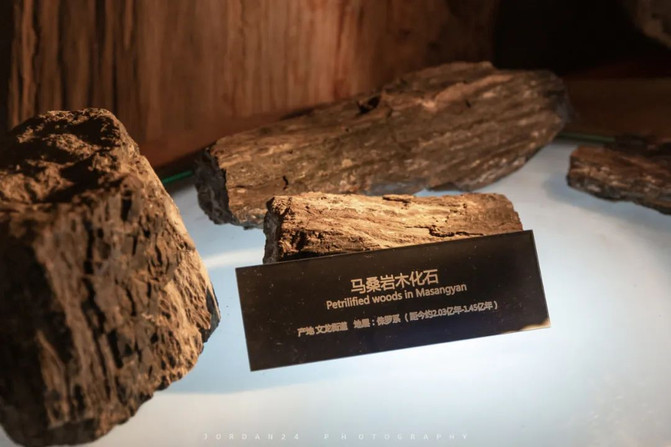
Unit 4 Dinosaur World
Dinosaurs are mysterious animals. Entering the Dinosaur Hall, information about ancient life came rushing in. We often see dinosaur skeletal fossils, but dinosaur footprint fossils are extremely rare. At the Qijiang Museum, the 5 treasures of the museum will definitely leave you amazed!

Treasure of the Town Hall "Sea Lily Fossil"
On the wall, a painting of ink lotus hanging upside down? Actually, it's not a painting, but a fossil; It's not lotus flowers, but sea lilies. This sea lily fossil is our fourth "treasure of the museum". This fossil is 3.65 meters high and 1.86 meters wide. Sea lilies are not plants, but animals. They are a type of echinoderm plankton that lives in the ocean, with roots on top and leaves on the bottom, growing upside down and drifting with the current. From an ornamental perspective, this specimen has stems, flowers, and leaves, is huge in size, graceful in posture, complete in shape, and outstanding in appearance, making it a masterpiece among sea lily fossils.


Third floor Historical and Cultural Hall
The History and Culture Hall on the third floor includes seven parts: the Longstanding Qijiang, the Mysterious Qijiang, and the Red Qijiang. Qijiang is a place of outstanding people and a gathering of stars. During the Han Dynasty, there was a great Confucian scholar named Yin Zhen who set up an altar in Qijiang to give lectures. Qijiang farmers' printmaking was renowned both at home and abroad, and cultural and artistic treasures such as Yongcheng blowing, Shihao Yangxi, Hengshan Kunci, and Qijiang Bagu pottery were breathtaking.

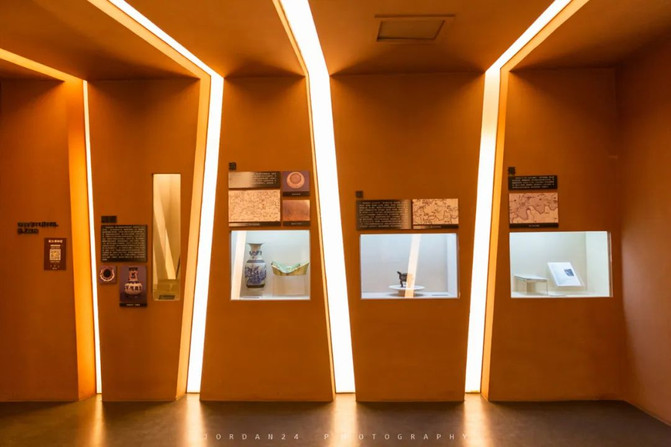
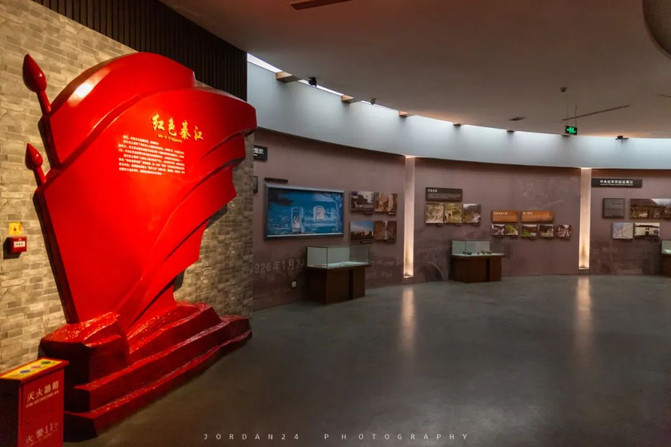





The tranquil and elegant Qijiang Museum not only carries the long history and culture of Qijiang, but also conveys to people the picture of a beautiful future for Qijiang

Seventh stop: Qijiang Farmers' Prints
The Qijiang Farmers' Prints originated from the wooden New Year paintings of the Ming and Qing dynasties. The paintings were first carved on wooden boards and then manually printed into pure handmade works. The composition of the works is bright and the colors are bright, and they are well-known both at home and abroad. It is an intangible cultural heritage project of Chongqing City, and Qijiang has been named the hometown of farmers' prints.

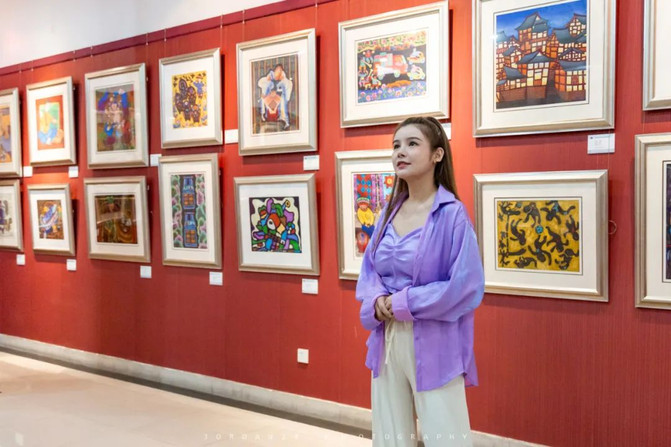
The themes are mostly drawn from the production and living practices of the vast number of farmers, with a strong national and folk customs and flavor of life. In art, a large number of folk art essence, such as wood carving, stone carving, cloth pasting, cross stitch, Paper Cuttings, wood board New Year pictures, blue calico, and so on, are widely spread among the people. Plate materials have developed from wood to stone, paper, and other materials. Ink colors and printing techniques are increasingly rich. The works always present simple, naive, exaggerated and romantic artistic effects, with unique national style and distinctive regional characteristics.


I have been invited to exhibit in countries such as the United States, the United Kingdom, Canada, France, and Japan. Many of my works have been collected by the National Art Museum of China, provincial (municipal) museums, Chinese embassies abroad, foreign art museums, and foreign friends.

In recent years, Qijiang has increased its support for farmers' printmaking, promoted printmaking into primary and secondary school classrooms, established printmaking studios, printmaking companies, and continuously derived the printmaking industry. Qijiang people have innovatively integrated printmaking elements into daily necessities and tourism products, producing and publishing art style handbags, folding fans, scarves, umbrellas, wine utensils, and other cultural and creative products.



Beidu Fish: Qihe Spring Beidu Fish, Wuji Time honored Brand
Address: About 100 meters southeast of the intersection of Jiulong Avenue and Gongshang Branch Road in Qijiang District (north of Jinfu Garden)
Beidu Fish became famous in the 1980s and is renowned both domestically and internationally. It comes from the Beidu Ferry crossing of Qijiang River. The method is to shell and scale live fish, burn them in a clay stove, add fresh fish, sprinkle a lot of chili peppers, Sichuan peppercorns, garlic, and some unique seasonings on top of the pot, and then drizzle with secret boiling oil. This way, Beidu fish is fresh, fragrant, numbing, spicy, tender, and refreshing, becoming a famous martial arts dish.

Now we have developed the classic practice of "one fish and four foods", such as spicy fish, tomato fish, pickled Chinese cabbage fish and fish head soup, which has become a famous Chinese dish.

Stable lamb meat Liu Jiazheng Street Lamb Meat
Address: Yangyang Village, 100 meters from the exit of An'an Town Expressway (Lanhai Expressway An'an Toll Station)
An'an lamb has a history of more than 200 years, adopting traditional techniques and secret formulas. It has been listed as an intangible cultural heritage of Qijiang District and has been awarded the title of "Chongqing Time honored Brand". Due to its unique cooking method, it has been highly praised by diners.
Yangmaimei uses local goats, and the lamb soup is really fresh with a chewy texture. This restaurant has been open for decades and is an intangible cultural heritage.

An'an Lamb has launched a variety of dishes including clear soup, red soup, braised lamb, fresh lamb, special steaming basket, special grilled lamb chops, braised lamb chops, special grilled lamb slices, special lamb hooves, roasted lamb liver, nutritious Erbao health soup, and more, all of which are popular among diners.

Crispy Wan Fish Whole Fish Feast
Address: Crispy Wan Fish Farm, Huilong Village, Shanzhen
Wan fish is named after its sturdy meat, abundant meat with few bones, refreshing taste, and crispy mouth. It has a more delicious taste and unique characteristics of soft, smooth, and crisp meat, especially the best part of the fish belly. Due to the toughness of this fish meat, there are various cooking methods, such as stir frying, steaming, and stewing, each with its own flavor. Crispy grass carp itself has a very rich nutritional value, which can be comparable to salmon and eel. Today, we recommend this "one fish, six flavors" crispy grass carp whole fish feast

It can be made into several flavors: spicy fish floss, diced fish with double peppers, cold fish fillet, sweet and sour fish steak, braised fish head, fish flavored shredded fish
Crispy Bay Fish 68 yuan/jin, Carp Soup 38 yuan/jin
Other specialties
Dongxi fermented bean curd, rice disaster, Jinjiao Laochuan beef jerky

High speed railway: Chongqing Xiqi Jiangdong, 26 minutes, 22 yuan/person
Self driving: Chongqing main city - Inner Ring Expressway (G75 Lanhai Expressway), 1 hour, 10 minutes, 70 kilometers, toll fee of about 20 yuan
Hengshan Flower Fairy Valley:
Previous Article:On weekends, explore niche Chongqing, ancient towns, forests, hot springs, and delicious food - there's no shortage of them all
Next Article:Holiday in Chongqing in late April (Strategy)
